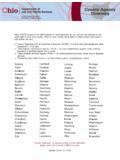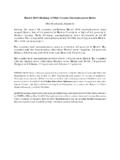Transcription of OHIO DEPARTMENT OF HEALTH COMMUNICABLE …
1 ohio DEPARTMENT OF HEALTHCOMMUNICABLE disease CHARTDISEASEINCUBATION AND SYMPTOMSMETHOD OF TRANSMISSIONCONTROL MEASURESOTHERP hone ContactsAnimal bitesSexually Transmitted DiseasesStandard Precautions in Child CarePrevention: Prevent access of stray or wild animals to school and child care premises. Bat proof buildings to prevent bats from entering. Choose classroom pets wisely; avoid contact with reptiles and exotic animals. Schools must comply with Jarod s Law (OAC 3701-54) on animals in school settings. All visiting pets should be healthy, properly vaccinated, and under adult a bite occurs: Confine the animal or obtain an accurate description so it can be located later. Immediately wash wound with soap and rinse with water for at least 10 minutes. Refer to a physician for appropriate medical care. Report the bite to the local HEALTH in HEALTH Education Classes: Teach appropriate behavior around animals. Be aware of and avoid wildlife and unfamiliar dogs or cats; they may be dangerous.
2 Discourage contact with injured or frightened animals; they are more likely to bite. Encourage proper immunization of pets against rabies. Stress the importance of telling an adult when a bite Hotline:1-888-Rabies1 Students suspected of having STDs should be referred to a family physician, local HEALTH district, or other appropriate medical resources for prompt diagnosis and regarding STDs must be held in strict confidence. Refer to ODHS exually Transmitted disease Summary Chart for additional information. To order the STD Summary Chart, call any other questions regarding STDs including STD transmission, call: Hotline:1-800-332-2437 Notify parents of all children who may have been exposed to a COMMUNICABLE disease . Tell them what signs and symptoms to watch for in their child and to seek medical care should these those children who were exposed to COMMUNICABLE diseases for signs and symptoms of illness so that secondary casesare detected the single most effective measure to prevent the spread of disease .
3 All children and staff shouldpractice good hygiene and should wash hands thoroughly upon entering the center, after toileting or diaper changes, afterwiping noses or covering coughs and sneezes, and before preparing or eating of contaminated articles and surfaces should be done, following a soap and water wash to remove physical soil. A chlorine bleach solution (1/4 cup bleach + 1 gallon of cool water) or (1 tablespoon of bleach + 1 quart of water)is aninexpensive way to sanitize, but it cannot be used on all surfaces. Leave surface wet for 2 minutesafter spraying. Wipe or air dry. This solution can be mixed in a spray bottle for convenience. It should be made up fresh daily to insure , such as non-porous disposable gloves, should be worn when contact with blood and body fluids containing bloodcannot be Child Care Licensing SpecialistAn equal opportunity employer/providerThis chart has been developed cooperatively between the Bureau of Early Intervention Services, ohio DEPARTMENT of HEALTH and the Bureau of ChildCare and Development, ohio DEPARTMENT Job andFamily reorder charts use this website and the form number 08087 (Rev.)
4 9/2009) DEPARTMENT of Job and Family ServicesFor diseases not listed, for more information, or to report cases of disease , contact your local HEALTH report any pattern of illness which is unusual for your center or any unusual increase in occurrence of questions about child care licensing rules, contact your local child care licensing region by calling the ODJFS Help Desk at 866-886-3537 followed by Option questions about K-12 school institution rules relative to COMMUNICABLE diseases and required immunization schedule,please contact the ODH School Nurseat 614 Immunization Program for immunization questions 614- Used Phone NumbersLocal HEALTH DistrictChickenpox(Varicella)Incubation: 10 21 days, usually 14 16 :Skin rash which progresses to blisters, then scabs. Eruptions occur in crops, so all three stages may be present simultaneously. Covered body areas are often most affected. Slight fever and malaise are also typical.
5 Reactivation of the virusresults in contact with drainage from sores of infected person; indirect contact with itemssoiled with drainage from such lesions (sores); respiratory droplets; airborne. Rare direct transmission can occur from shingles lesions. Scabs are not period:1 2 days before rash appears, through maximum of 6 days after appearance of :Exclude until the sixth day after onset of rash, or until all lesions (sores) are dry. Staff or children with shingles(Herpes Zoster) shall keep sores covered by clothing or a dressing until sores have crusted. Handwashing should beemphasized for those touching lesionsImmune-suppressed children or those with chronic diseases like leukemia are at highest risk for complications. All staff members and parents shall be notified when a case of Chickenpox occurs, including the greater likelihood of serious infection in susceptible adult and pregnant women. Contact parents of children who have not been immunized.
6 Do not treat with aspirin products due their strong association with Reye shall be reported by th end of the work week in which the existence of such cases is known to your local healthdistrict. Vaccine ColdIncubation:Between 12 hours and 5 days, usually 48 :Sore throat, watery discharge from nose and eyes, sneezing, fever, chills,generalized contact with infected person; indirect contact with items freshly soiled with nose and throat discharge of infected person, and inhalation of respiratory hands carry viruses and bacteria to mucous membranes of eyes and period:24 hours before onset of symptoms through 5 days after onset (may vary).Control:Exclude children with fever and those who feel ill; other exclusion is and disinfect / sanitize all common surfaces and toys on a daily should be washed after contact with oral or nasal discharge, such as after wiping a nose. Use disposable tissues; use only once and discard.
7 Avoid touching or rubbing (Pink-eye) (Bacterial)Incubation:Bacterial, 24 72 :Redness of eye or eyelid, thick and purulent (pus) discharge, mattedeyelashes, burning, itching or eye contact with discharge from eye membranes or upper respiratory tract. Indirect contact by touching items contaminated with such discharge, such as fingers, clothing, toys, or other period:Bacterial Until 24 hours of antibiotic treatment completed. Control:Exclude those with purulent (pus) eye discharge, or eye pain, or eyelid redness or fever until after 24 hours of treatment with an good handwashing , unusual incidence, or epidemics of Conjunctivitis shall be reported by the end of the next business day afteroutbreak, unusual incidence, or epidemic is known to your local HEALTH :2 9 days, depending on causative :Acute respiratory infection involving the epiglottis, larynx, trachea, andbronchi. May cause respiratory distress ranging from mild to severe.
8 Cough has a barking or brassy harsh quality. May notice a high pitched sound on contact with infected person, airborne, or indirectly by objects soiled by respiratory period:Duration of the cough ( disease ).Control:Exclude until severe symptoms are gone. Medical attention is necessary. Major complications can occur. Upper respiratory infection often precedes croup. Croup may be caused by virus or DiseasesIncubation:Varies depending on causative :3 or more loose stools (stools with increased water content and /or decreasedform) in a 24 hour period. Persons with diarrhea may have additional symptoms includingnausea, vomiting, stomach aches, headache or contact, in the majority of cases, by fecal-oral route: ingesting fecal particles found on inapparently contaminated objects or hands. Diarrhea can also be spread by contaminated food and period:Varies with causative agent. disease spreads more easily among children in diapers and staff caring for :Children with diarrhea who attend a child care center or persons with diarrhea who work in a sensitive occupation(direct food handling, direct patient care, the handling of food or provision of direct care to child care center, or any otheroccupation which provides significant opportunity for an infected individual to transmit infectious disease agents) shall beexcluded from the child care center or work and may return only after diarrhea free for 24 hours or the diarrhea has beenevaluated medically to be non-infectious and can be contained by a diaper, potty or toilet.
9 A person with infectious diarrheaof known cause shall be excluded in accordance with the provisions for the specified causative agent as listed below:Campylobacter As above PLUS a food handler may return to work only when the food handler has had at least 48 hours ofeffective antimicrobial therapy OR the food handler has had 2 consecutive follow-up stool specimens that are difficile (C. difficile) infectious disease which may be spread to others, however, only people in HEALTH caresettings or on antibiotics are likely to become ill. To prevent the spread, good handwashing technique must be rubs should be avoided because they are not effective against spore-forming bacteria. Recently a new strain has been reported to CDC which has caused hospital outbreaks in several states. May return to school or work after diarrhea freefor 24 hours. Refer to the ODH website for additional infection control guidelines: As above PLUS a food handler may return to work only after 3 consecutive follow-up stool specimens are coli 0157:H7,HUS, Shigella As above AND after 2 consecutive follow-up stool specimens are As above AND after 72 hours of effective antimicrobial therapy OR after 3 consecutive follow-up stool specimens are negativeRotavirus/Norovirus Follows general control measures , Yersinia As above PLUS a food handler may return to work only after 2 consecutive follow-up stool specimensare handwashing and good personal hygiene are fundamental measures in the control and prevention of diarrhealdiseases.
10 Staff and children should be educated regarding fecal-oral transmission. In a child care center, thoroughhandwashing by children and staff after diaper changes and toileting and before preparing, serving, or eating food isessential. Personnel handling food should not care for diapered 2 or more children or staff members in one classroom of a child care center experience diarrhea within a 48 hour period, an infectious agent should be suspected. Notify your local HEALTH DEPARTMENT . Stool testing may be children often have loose stools more frequently; this normal condition should not be confused with if there has been a change in frequency for the breastfed infant whose stools may normally be watery coli 0157:H7,HUS, Shigella, and Salmonellashall be reported by end of the next business day after the existence of suchcases or suspect case is known to your local board of , Cryptosporidium, Giardia, and Yersiniashall be reported by the close of the working week in which theexistence of such case or suspect case is known to your local board of HEALTH .





